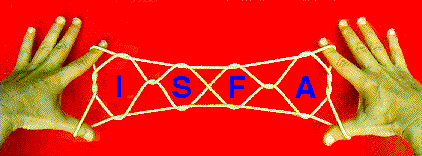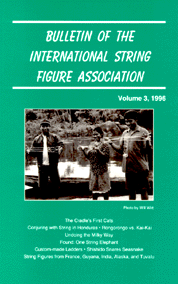Volume 3 (1996): 190 pages - Table des Matières
Edité par - Mark A. Sherman, Pasadena, California
Rédacteurs Associés - Joseph D'Antoni, Queens, New York; Myriam Namolaru, Haifa, Israel;
Belinda Holbrook, Davenport, Iowa; Stephan Claassen, Best, Netherlands.
Comité de Rédaction - Hiroshi Noguchi, Tokyo, Japan; Philip Noble, Inverness, Ecosse
Le Bulletin de l'Association Internationale du Jeu de Ficelle (BISFA) est une publication savante
présentant des documents originaux qui fait progresser notre compréhension et renforce
notre plaisir des jeux de ficelle. BISFA est publié annuellement, en septembre, par ISFA Press
(Pasadena, Californie). BISFA remplace le Bulletin de l'Association des Jeux de Ficelle,
(Toky Nippon Ayatori Kyokai), qui a été publiée en 19 volumes (1978-1993).
Les traductions proposées ne comprennent pas les illustrations et photos du texte original.
J'ai traduit ces textes pour vous donner un aperçu de la qualité et de la richesse de
ces publications.
Commentary
- The Cradle's First Cats: A History of the International String Figure Association, by Hiroshi Noguchi, Tokyo, Japan, and Philip D. Noble, Prestwick, Scotland, (pages 1-7) - Includes an index of Ayatori News and Ayatori, the Japanese edition of our Bulletin.
Review Articles
- Shamanism and String Magic of the Tolupan of Honduras: A Summary and Partial Translation of an Article by Anne M. Chapman, by Sam Cannarozzi Yada, Chasselay, France, (pages 8-13) - The association of string figures with spiritual beliefs and taboos is well documented. This article describes a related practice observed by Anne Chapman among the Jicaque (Tolupan) of north-central Honduras in which a shaman manipulates four pieces of string in order to divine the answer to a question. Chapman's observations were originally reported in her article entitled "Chamanisme et Magie des Ficelles Chez les Tolupan (Jicaque) du Honduras," which appeared in Journal de la Sociיtי des Amיricanistes du Musיe de l'Homme, Paris (vol. 59, pp. 43-64, 1970).
- Rongorongo versus Kai-kai: A Look at Parallel Themes in Easter Island's Mysterious Script and String Figure Repertoire, by Sergei V. Rjabchikov, Krasnodar, Russia, (pages 14-21). - Many parallels exist between the themes encoded within Easter Island's rongorongo script and the ancient chants associated with the island's traditional string figures. In fact, some of the string figure designs physically resemble glyphs inscribed on the rongorongo boards. Six examples are presented that illustrate the underlying connections.
- The Arctic String Figure Project -- Part 1: Gordon's Alaskan Figures, by Richard Darsie, Davis, California, Ronald C. Read, Oakville, Ontario, Canada, and Mark A. Sherman, Pasadena, California, (pages 22-50) - Revised methods for making twenty Inuit string figures gathered in the Bering Strait region of Alaska by G.B. Gordon are presented. Illustrations of intermediate stages are included.
Research Reports
- Jeux de Ficelle à la Française, par Sam Cannarozzi Yada, Chasselay, France, (pages 51-55) - Les jeux de ficelle sont bien vivants dans la campagne française! Cet article décrit les noms français associés à plusieurs motifs. Les méthodes pour réaliser trois des figures sont inclues.
- Zoo du Jeu de Ficelle: Variations de "Caribou" Inuit par Masahiko Eguchi et Kazuo Kamiya, Saitama, Japon, (pages 56-62) - Le regretté Dr. Eguchi était un inventeur prolifique de jeux de ficelle. Cette article décrit la manière de réaliser les neuf variations de "Caribou," un motif traditionnel Inuit . Les variations, ont toutes des noms d'animaux, et comprennent la girafe, "Bambi," une antilope, un chat, un rat, un caribou avec une ramure fantaisiste, un renard,un éléphanteau, et un éléphant adulte.
- String Figures from Guyana, by Will Wirt, Port Angeles, Washington, (pages 63-87) - Investigators working early this century in the rain forests of what is now Guyana wre mesmerized by the often complex and unique string figures made by the local inhabitants. Remarkably, many of the figures they collected are still known in the region. In this article I describe eighteen string figures and three tricks I observed recently in the remote Wai Wai village of Ahkutho, located at the southern end of the country. Twelve of the twenty-one games I observed are made using methods previously unrecorded from Guyana.
- Sur la relation entre la Série du Jeu de Ficelle "Voie lactée" et "Un Vol d'Oiseaux" par Masahiko Eguchi et Tetsuo Sato, Kumamoto, Japon (pages 83-88) - Un jeu de ficelle cyclique est une série de motifs dans laquelle le premier et le dernier sont les mêmes. Par conséquent, la série peut être répétée à l'infini, sans pause. Cet article décrit comment deux séries du jeu de ficelle étroitement apparentées, la "Voie Lactée" de la Papouasie Nouvelle Guinée et "Une Volée d'Oiseaux des Iles Loyales", forment un cycle lorsqu'elles se fondent "Voie Lactée" est donc l'inverse de "Une Volée d'Oiseaux."
- String Figures from India, by Joseph D'Antoni, Queens, New York, (pages 89-92) - Though string figures enjoy a worldwide distribution, very few are known to originate from the Indian subcontinent. Of the few figures that are recorded in this article, two are alternate constructions of previously published figures, and the other is new.
- Ladder String Figures: A Systematic Approach, by Tetsuo Sato, Kumamoto, Japan, (pages 93-107) - Ladders are string figures consisting of a single row of diamonds or "steps." The string intersections that define each diamond range from simple crossings to complex wraps. This article presents a systematic approach for designing ladders with as many steps as desired using one or two loops. The article concludes with an introduction to Tatsuhide Kamiya's analytical procedure for calculating the weaving sequence of any ladder whose "knot sum" falls between -1 and +1.
- The Reconstruction of the Remaining Unsolved Nauruan String Figures, by Yukio Shishido, Kyoto, Japan, (pages 108-130) - Of the fifteen Nauruan string figures illustrated in Jayne's 1906 book, two have consistently eluded efforts to decipher how they were made. This article presents methods for making both of them using mostly Nauruan techniques. The author demonstrates that the analysis of a string figure's fine structure is essential to the process of reconstructing its method.
- The String Figures of Tuvalu (Ellice Islands), by Honor C. and Harry E. Maude, Canberra, Australia, (pages 131-162) - To date, our knowledge of the Tuvaluan string figure repertoire derives primarily from a short film made by German ethnographer Gerd Koch in the early 1960s on the northern island of Niutao. This paper presents additional figures gathered by us in 1931 on the southern islands of Vaitupu and Funafuti, as well as a few gathered earlier by Sir Arthur F. Grimble, a former Resident Commisioner of the Colony. Two string tricks are also included.
Book and Video Reviews - by Joseph D'Antoni and Mark Sherman (pages 163-169)
- String Figures from Around the World I and II, by Sorena De Witt.
- Cat's Cradle Fun, by Kate Mason.
- Cat's Cradle, by Anne Akers Johnson.
- String Games from Around the World, by Anne Akers Johnson.
- String Figures, by A. Johnston Abraham.
- String Figure Magazine, published by ISFA Press.
- Schnurfiguren aus aller Welt, by Felix R. Paturi.
- Kwakiutl String Figures, by Julia Averkieva and Mark Sherman.
- String Figure Bibliography, by Thomas F. Storer.
- String Things...Stories, Games, and Fun! (Videotape), by Barbara G. Schutz-Gruber.
Literature update (pages 170) - seven recently discovered articles about string figures.
Letters to the Editor (pages 171-180)
- It's a Small World After All - Sergei V. Rjabchikov, Krasnodar, Russia. On cultural ties and possible prehistoric contact between the Ainu, Eskimos, and the peoples of Oceania. Includes Editor's reply on a possible explanation for closely related string figures in the Hawaiian and Pacific Northwest Coast repertoires.
- Mine or Ours? - Sam Cannarozzi Yada, Chasselay, France. A protest about the practice of copyrighting string figure performances.
- Chacun Son Got - Joseph D'Antoni, Queens, New York. A letter defending the systematic study, classification, and creation of string figures.
- Ready Set -- Action! - Philip Noble, Prestwick, Scotland. On using "flick books" to teach string figures. Also discusses the use of a video camera to make string figure animations.
- In Honor of Honor - Dr. Tom Storer, Ann Arbor, Michigan. A letter drawing attention to the recent opening of the Pacific Islands Library Collection at the University of Adelaide, Australia. The collection was donated by Professor Harry E. and Honor C. Maude.
- Nauru, Pacifique Central , 16 Octobre, 1937 - Honor Maude, Canberra, Australie. Reproduction d'une lettre écrite par Honor Maude à sa belle-mère pendant son séjour à Nauru passé à recueillir des jeux de ficelle.
- Elles Ont Toujours une ficelle sur elles - Dr. Henry Rishbeth, Southampton, Angleterre. Reproduction d'un article de journal de 1956 décrivant une rencontre entre Kathleen Haddon et Honor Maude, deux des plus grandes autoritées au monde sur les jeux de ficelle.
- Served with a Twist - Yukio Shishido, Kyoto, Japan. On the similarty between two of Shishido's invented string figures (helix variations) and two traditional Oceanic figures.
- A Gathering of the Clans - Audrey Collinson Small, Paradise, California. The author suggests that ISFA should sponsor an international conference.
Modern String Figures (pages 181-187)
- Vampire Bat, Lizards Kissing, Landscape, Dogface, and Four Pentagons - invented by Edward Jackman, Los Angeles.
- Verre à Vin - inventé par Carey Smith, Stratford, Nouvelle Zélande
- Book'em Dano - invented by Tom Storer, Ann Arbor, Michigan.
- Egg'phthathl - shown to Homer Sapiens, somewhere in California...
Back Issues, Publications of ISFA Press (page 188)
Commentaires
-

- 1. painting company in dubai Le 14/12/2020
What Now i'm getting at certainly is the idea which usually price isn't really the sole factor every customer decides a application contractor. The actual largest excuse Document hear right from paint builders is make either get rid of excess jobs as their fee is too much or always estimate an occupation correctly. -

- 2. full time maids in dubai Le 14/12/2020
Consult family and also companions that have contracted washing specialist government. Approach individuals you understand for recommendations of organizations that they've utilized efficiently. Begin your quest for an firm by attaining these word-of-mouth first. In the few illustrations, organizations gives rebates to be able to clients which elude new clients, so get some good information concerning any added frameworks create. -

- 3. babysitting services Le 27/09/2018
Sitter Select, a locally owned and operated Philadelphia babysitter service, provides qualified, reliable babysitters for all age levels throughout the city. We have met, interviewed and thoroughly vetted the sitters on our team, making it easy for your family to get to know a local babysitter. Whether it is for a date night, mother’s helper a couple of days per week or a standing sitter for long term needs, we look forward to helping you with find the babysitter that suits your family.
Ajouter un commentaire






